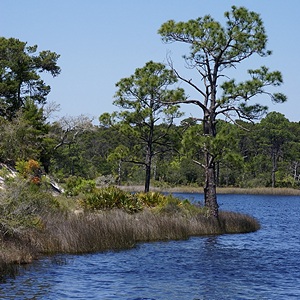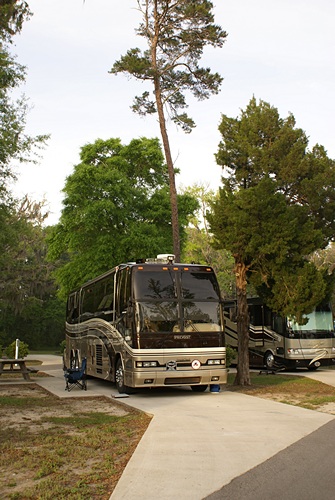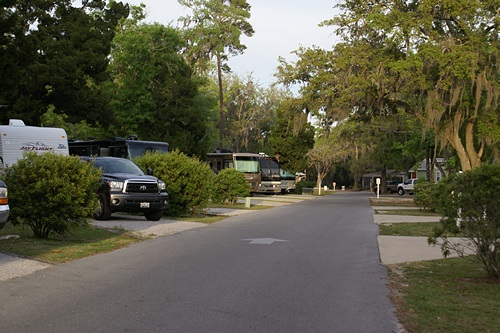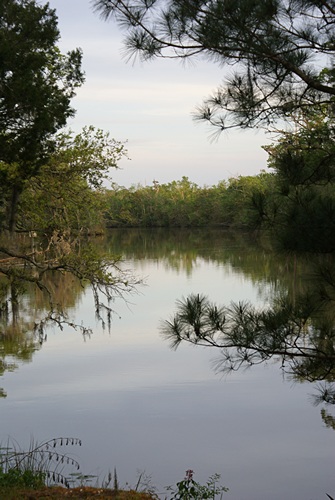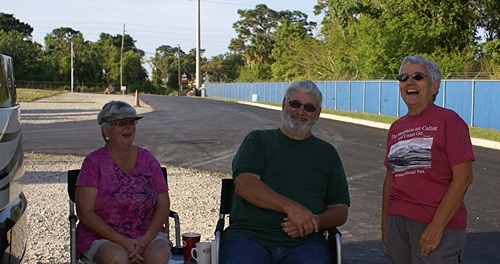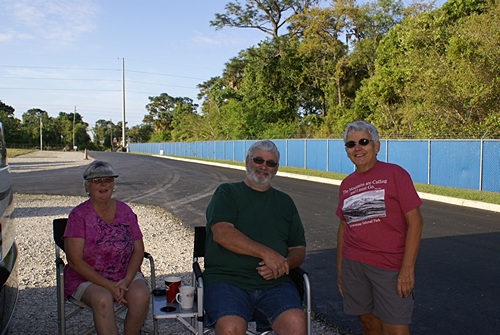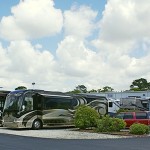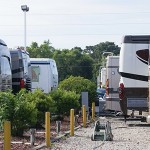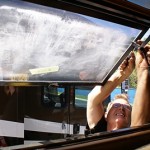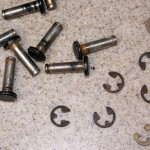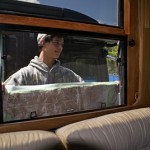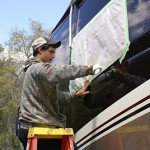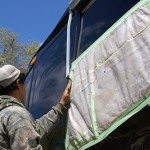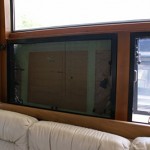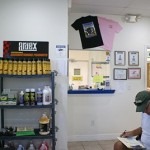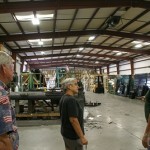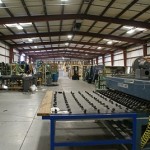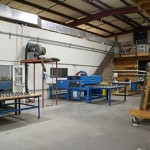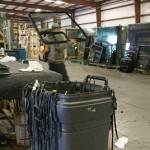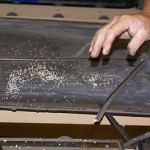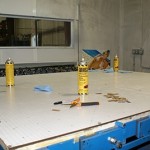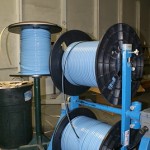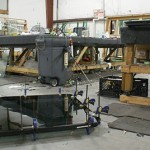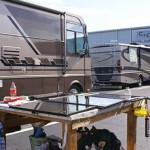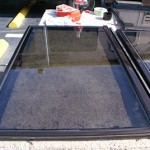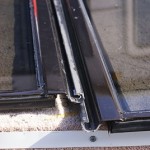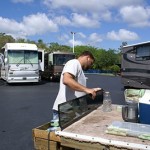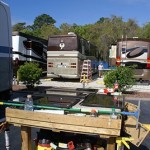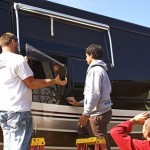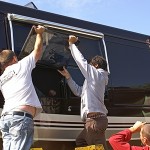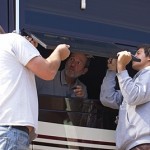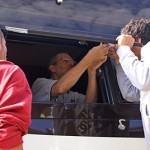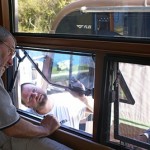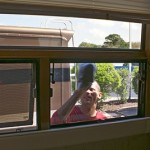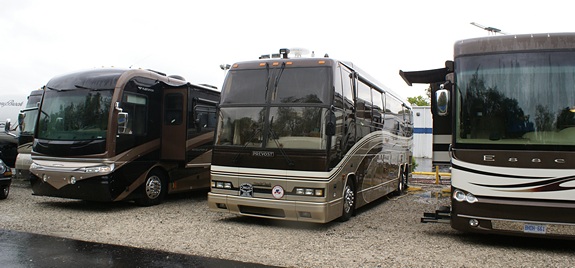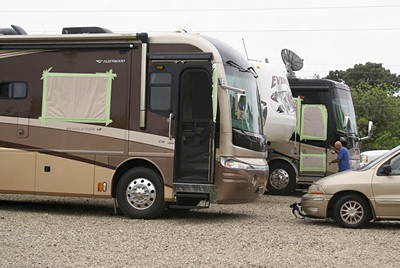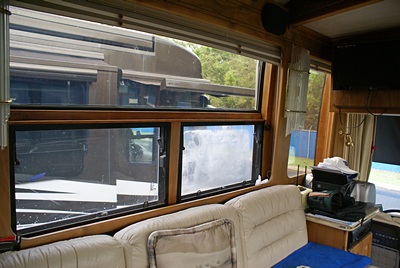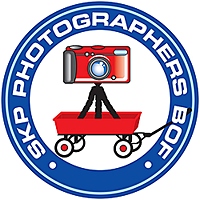The outside air temperature dropped into the 40’s last night. I closed the roof vents before turning in but we left the windows open a bit. It was 61 degrees F in the kitchen when I got up at 8 AM so I turned on the Aqua-Hot, turned up all three thermostats, and turned on the front electric toekick heater. I fed the cats and then made our morning coffee. Linda got up around 8:20. After our first cup of coffee we had granola for breakfast. When the temperature in the coach reached 70 I turned off the thermostats and the electric heater and shut off the Aqua-Hot diesel burner. (The electric heating element in the Aqua-Hot stays on whenever we are plugged in and living in the coach.)
I called Suncoast Designers and talked to Donna. She talked to the technician and reported back that the bus window would be ready for pickup at 3 PM. The office closes at 3:45 PM, so I would need to be there close to 3 to get it and settle the bill.
I found my water usage spreadsheet, which I last updated on April 19 of this year, and edited it to include the dump and fill activity since then. I had to go back to my blog posts from late April to confirm just what I had done and when I had done it. I checked my most recent post drafts and discovered that I had not made mention of dumping here at WCRVR. Linda and I agreed that it was not the day we got here and not the following day so I recorded it as the 3rd. Since there had been large time gaps in our use of the coach, and I had dumped the fresh water tank and refilled it the day before Thanksgiving, I had to reset the spreadsheet to known starting points.
After entering the missing data I determined that, with two people living in the coach, we continue to use fresh water at the rate of approximately 12 gallons per day and fill the waste tanks at the rate of approximately 12 gallons per day; five for the black tank and seven for the gray tank. With 120 gallons of fresh water that means we can boondock for about 10 days, during which time we would use up the 120 gallons of fresh water and add roughly the same number of gallons to the two waste tanks, 50 to the 80 gallon black tank, and 70 to the 120 gallon gray tank. I also determined that we have used about half the capacity of the water softener.
The numbers for the waste tanks are very rough as our tank level monitors do not work and I cannot see the levels in the tanks, even though they are translucent white plastic, as they are hidden behind “beauty panels.” Still, I think my estimates are reasonable. Given the 3:4 ratio of fresh:waste tank capacity I am inclined to redo the water bay next spring as a 300 gallon, 2-tank, system replacing the current 330 gallons of combined tank capacity (125 fresh, 125 gray, 80 black). I could reuse the current 125 gallon fresh tank but I would probably replace it with one of a different shape to make room for the water softener and filters to be built in and to relocate the fresh water pump to the driver side floor at the level of the bottom of the fresh water tank.
At current usage rates a 125 gallon fresh water tank and a single 175 gallon waste tank would, hypothetically, allow us to boondock for 13 days, running out of fresh water just as our waste tank reached capacity. We might be able to stay out longer if we could reduce fresh water usage and waste generation proportionally. In practice, however, we would probably not go more than 13 to 14 days and only then if the new tank monitors worked accurately. Still, that would allow us to stay out two full weeks before we had to dump and fill, which seems like a good amount of time.
The other benefits of reconfiguring the tanks in the utility bay include slightly different tank shapes that would create some space for the water softener and filters and provide access to the tanks for servicing and monitoring. It would also allow me to install rotating spray heads for the waste tank and drain it through the macerator pump, allowing use to “dump” our tanks at our house or anywhere we could get a garden hose into a waste drain. We might even gain space, or access to space that is already there, to store drain hoses, and other utilities-related things, in the bay. I would, for instance, love to have a shorepower reel but I do not think I can create that kind of space without making the tanks too small.
What we would lose in the redo is a separate gray tank that could, hypothetically, be drained onto the ground in some places. The number of places where that is legal, however, is too small (in my opinion) to justify keeping that capability. The other main argument for keeping separate black and gray waste water tanks is that the contents of the gray tank can be used to flush the drain hose out after first dumping the contents of the black tank. Indeed, some bus converters set up their waste tanks with the gray tank above the black tank and plumb them so that the gray tank can be drained into the black tank to help flush it out, or drained directly (which leaves open the option of draining it in on the ground).
We heard another interesting take on water management for boondocking at a seminar in August 2012 at the FMCA national rally in Madison, WI. The presenter described his system, which involved three tanks, fresh, gray, and black. His twist on this was that he ran the gray water through a filter (or set of filters) and then used it to flush the toilet. The advantage is that all of the fresh water becomes available for gray water use, i.e., cooking and cleaning. As an example, consider a setup (such as we might have in our bus conversion) with a 150 gallon fresh water tank, a 100 gallon gray tank, and a 50 gallon black tank. Since the first 50 gallons that go into the gray tank will potentially end up in the black tank the entire 150 gallons of fresh water can ultimately end up in the 100 gallon gray tank. With careful management of water usage, that could really extend the amount of time the rig can be used without hookups. These tanks could be sized differently, larger waste and smaller fresh, if you had a fresh water bladder that could be used to retrieve additional fresh water and refill the tank without moving the RV. Lot’s of interesting possibilities, all of which involve engineering design tradeoffs.
I opened the box of BCM back issues that arrived yesterday and went through them. There were two of each issue but I won’t know if they are all there until I can integrate them into the partial sets I brought from home. Those sets were under the bed and there was a cat on the bed so retrieving them would have to wait until later. I worked on this post for a while instead and stopped at noon to have lunch. Linda made peanut butter and jelly sandwiches and sliced an apple. Simple but delicious.
I looked through the articles in my BCM “in process” folder and opened the one on tips for taking photographs to see how complete it was. While not finished, the article was much more than an outline. I spent about 20 minutes reviewing what I already had and doing some additional editing but did not feel like digging into in it.
I left at 1 PM for Hudson, taking the same route I took yesterday, and arrived at 2:45 PM. I was 15 minutes early but the window was done. There was no charge for the repair, which I appreciated, as the seal failed not long after the window was originally fixed in April 2014. The technician wanted the window to stay horizontal for at least another day, supported by its frame, before being reinstalled in the bus. Because the back of the car was full and could not be rearranged I moved the passenger seat all the way forward and leaned the seat back as far as it would go. I used the blanket to plug the gap between the front edge of the seat and dashboard and set the window in place, outside up, with one short edge on the blanket and the other one on the seatback. It traveled very well that way on the drive home and I decided it was safer to leave it there than setting it out on the picnic table overnight. I got back to the rig around 5 PM even though I stopped twice, once for popcorn at Rural King, and then at McDonald’s for a diet pop.
Linda made seitan vegan stroganoff for dinner which we enjoyed with a glass of Mimbres Red table wine from St. Clair Winery in Deming, New Mexico. In retrospect we should have bought more bottles while we were there. Every wine we bought from them was a red and very much to our liking, especially mine, which is unusual.
We had both spent most of the day sitting on our butts (not our hands) and went for a brisk stroll after dinner. We watched a few TV programs, went to bed at 10:30, and finished watching Rick Steves’ Europe before turning out the lights.
